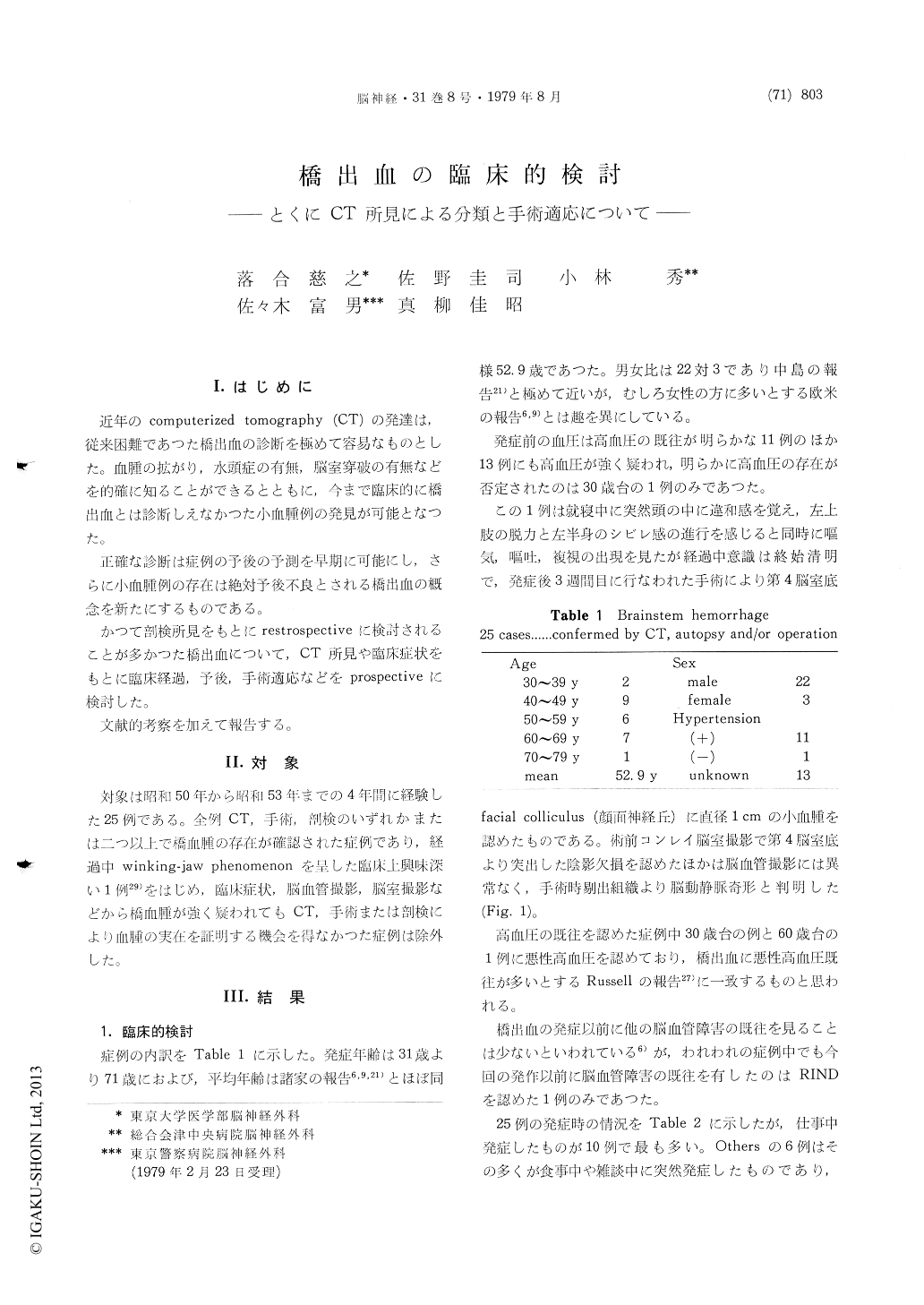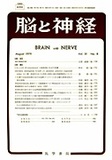Japanese
English
- 有料閲覧
- Abstract 文献概要
- 1ページ目 Look Inside
I.はじめに
近年のcomputerized tomography (CT)の発達は,従来困難であつた橋出血の診断を極めて容易なものとした。血腫の拡がり,水頭症の有無,脳室穿破の有無などを的確に知ることができるとともに,今まで臨床的に橋出血とは診断しえなかつた小血腫例の発見が可能となつた。
正確な診断は症例の予後の予測を早し期に可能にし,さらに小血腫例の存在は絶対予後不良とされる橋出血の概念を新たにするものである。
25 cases of pontine hemorrhage were seen in our clinic and in our affiliated hospitals from 1975 to 1978.
The male to female ratio was 22 to 3. The age ranged from 31 to 72 years with the mean of 52.9 years. 11 cases were confirmed to have had hy-pertension prior to the hemorrhage. In other 13 cases hypertension was suspected, although the past history was not obtained. Remaining one, aged in the thirties, which had no hypertension was a case of cryptic angioma (cryptic AVM). 60 per cent of cases suffered from rapidly progressing loss of consciousness as initial symptoms. There were, however, four cases which showed no disturbance of consciousness in the whole course of the disease. As symptoms and signs on admission, disturbance of consciousness was present in 84 per cent of cases. Motor disturbance, respiratory disturbance, abnor-mal pupils and abnormal ocular movement were also frequently seen.
17 cases of 25 cases were examined with CT on admission within five days after the onset. All of them were considered to be hypertensive hemor-rhage. They could be classified into three groups according to the size of hematoma. The cases in which the size of the hematoma on a transverse section through the mid pons was less than 1/4 of the cross section of the pons or the largest diameter of the hematoma was less than one cm were classi-fied into A group. Those in which the hematoma covered the whole tegmentum and the basis pontis and extended to the cerebellum were classified into C group. Cases with hematoma covering more than 1/3 of the cross section without extension beyond the pons were classified into B group. All the cases belonging to B and C groups died except one case living in a vegetative state. In contrast, in A group, all the six cases survived more than one month. The two of those six cases, however, later died of rebleeding and aspiration suffocation respectively. The other four cases are all alive without disturbance of consciousness and one of them is well and working. In these cases hema-tomas were located in the rostral pons and the lower mid brain. These results show that ourclassification is useful in predicting the prognosis of the case of the pontine hemorrhage.
Clinical courses of 25 cases and surgical indica-tion were examined according to levels of con-sciousness. Cases in coma from the onset or cases falling into coma within six hours all died within one week. Most of the cases in B and C groups belonged to this category. Those cases in coma submitted to surgery all eventually died. This fact reveals that there is no indication of operative treatment in those in coma. On the other hand, those who did not fall into coma gained long survival. Six cases of A group were all in this category. Two cases in semicoma or stupor under-went direct operation and one case in semicoma was treated conservatively. There was, however,no significant difference in recovery between sur-gically treated two cases and conservatively treated one. The other three cases of A group those who had no disturbance of consciousness are well with conservative treatment. Therefore even in cases of A group, if they are hypertensive, surgical indi-cation is doubtful except for cases with hydro-cephalus for which ventricular drainage may be indicated. For cases without hypertension and be-low the age of 40 years direct operation may be indicated, because in such cases hemorrhage may be due to rupture of cryptic angioma and neuro-logical deterioration may not be cured unless direct operation is done.

Copyright © 1979, Igaku-Shoin Ltd. All rights reserved.


